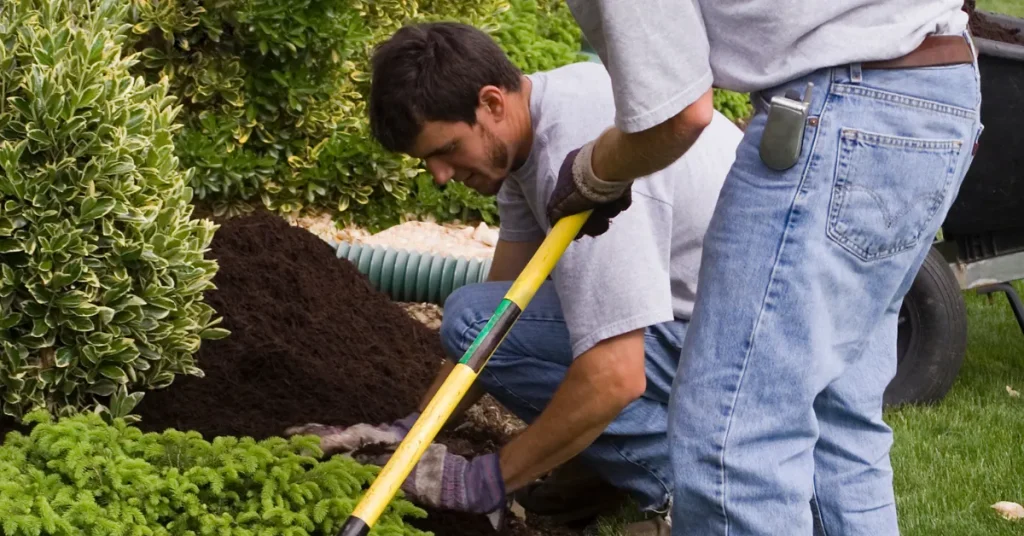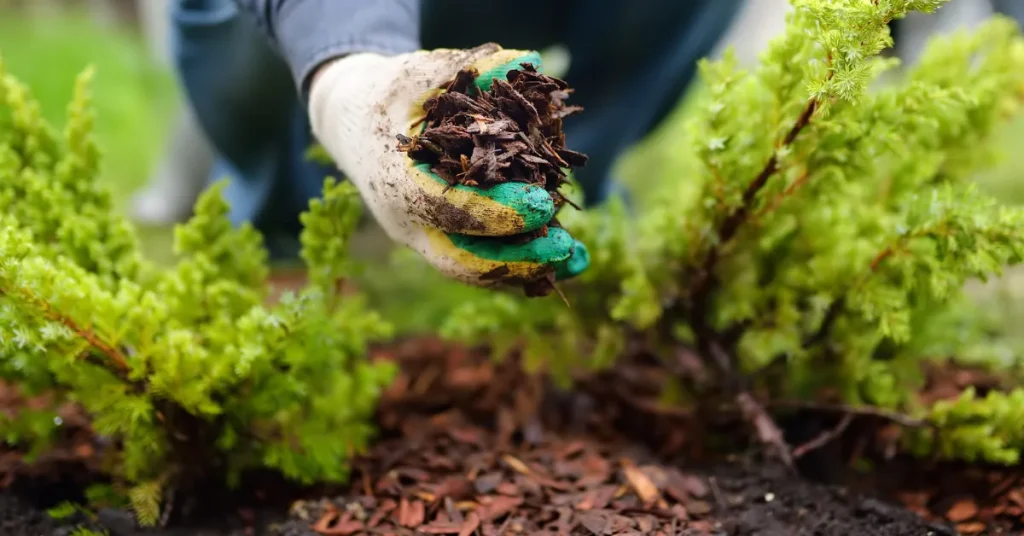Mulch should typically be applied to a thickness of 2 to 4 inches. Avoid exceeding this range to prevent plant suffocation and decay.
The strategic application of mulch greatly benefits garden health and aesthetics. It acts as a protective layer, locking in soil moisture and suppressing weed growth, while gradually enriching the soil through decomposition.
It offers an effective method for gardeners to maintain moisture levels, regulate soil temperature, and improve soil texture and fertility.
By choosing the right type and amount, gardeners create a conducive environment for plant development.
Balancing mulch thickness is key to ensuring plant roots receive necessary air and water without inviting pests or diseases. With the right approach, mulching can become an integral part of sustainable landscaping practices.

The Role Of Mulch In Gardens
Mulch serves as a protective layer over the soil in gardens. This layer regulates temperature, maintains moisture, and improves soil quality. A well-mulched garden bed can suppress weeds, keeping your garden neat and healthy.
Determining the appropriate thickness of mulch is crucial for plant growth and soil protection.
Benefits Of Mulching
- Moisture retention: Mulch reduces water evaporation from the soil.
- Temperature control: It acts as an insulator, keeping the soil warm in winter and cool in summer.
- Weed suppression: A thick mulch layer can prevent weeds from taking root.
- Soil improvement: Decomposing mulch enriches the soil with nutrients.
- Visual appeal: Mulch gives garden beds a neat, uniform look.
Types Of Mulch Materials
| Type of Mulch | Benefits | Best Use |
| Organic Mulch | Improves soil as it decomposes | Vegetable gardens, flower beds |
| Inorganic Mulch | Durable and long-lasting | Landscaping, pathways |
| Wood Chips/Bark | Natural look, good insulation | Trees, shrubs |
| Straw/Pine Needles | Prevents erosion, easy to apply | Sloped areas |
Decoding Mulch Thickness
Decoding mulch thickness is key to a garden’s health. A vital layer of organic material, mulch insulates the soil, retains moisture, and wards off weeds.
But, there’s a magic to mulching correctly. Not too thin, not too thick – just right holds the secret to a thriving garden.
Factors Influencing Mulch Depth
Understanding mulch depth factors ensures your garden flourishes:
- Plant type: Sensitive plants need a lighter mulch touch.
- Soil condition: Well-drained soil can handle deeper mulch.
- Climate: Cold regions often call for thicker layers to protect roots.
- Pest issues: Some bugs love hiding in thicker mulch, so balance is key.
Common Misconceptions
Let’s bust some myths:
| Misconception | Truth |
| “More is better.” | Too thick can suffocate plants. |
| “Any mulch works.” | The right type is crucial for effectiveness. |
Remember, 3 inches of mulch is a general rule for most gardens. Go beyond just applying – decode the layer to unlock your garden’s potential.
Ideal Mulch Depths For Different Scenarios
Gardeners often ask, “How thick should mulch be?” The answer depends on where it’s being applied. Every garden scenario requires a unique mulch depth. Let’s dive into ideal mulch depths for vegetable beds, woody perennials, and recreational areas.
Vegetable Beds
Vegetable beds thrive with mulch. It conserves moisture and warms soil. For most vegetables, a mulch layer between 2 and 3 inches is perfect. This depth maintains soil moisture without causing rot or inviting pests. Here’s a brief guide:
- Leafy greens: 2 inches to avoid stem rot.
- Tomatoes & Peppers: up to 3 inches to retain warmth.
- Root vegetables: 2-3 inches, avoiding direct contact with the crowns.
Woody Perennials
For shrubs and trees, a deeper layer encourages strong growth. Aim for 3 to 4 inches of mulch. This depth suppresses weeds and keeps roots cool. Ensure there’s a small gap around the base of the plants to prevent rot. Here’s how to apply:
- Create a doughnut shape: Mulch in a circle with a free space near the trunk.
- Avoid mulch volcanoes: Too much mulch against trunks can harm the plant.
Paths And Play Areas
Mulch can also cushion falls and create clean pathways. In play areas, 6 to 8 inches of mulch provides safety for children at play. Paths require less—about 3 to 4 inches. This keeps weeds down and makes for a firm walking surface. Remember:
- Choose proper material: Hardwood chips or bark are best for paths.
- Refresh regularly: Maintain depth yearly as mulch decomposes.
Applying Mulch Properly

Proper mulch application is crucial for healthy gardens. It keeps plants hydrated and wards off weeds.
Finding the right thickness ensures your garden thrives without suffocating plant roots or inviting pests. Let’s look at how to apply mulch correctly for optimal garden health.
Techniques For Even Distribution
Even distribution is key to effective mulching. Start by clearing away debris and spreading a thin layer of mulch around plants.
Use a rake or hands to spread it. Aim for uniform coverage across the garden bed. This prevents water pooling and mulch mounds that can harm plant growth.
- Use a rake for large areas.
- Employ a pitchfork for breaking up heavy mulch.
- For small areas, use hands with gloves.
Timing Your Mulch Application
The best time for mulching is late spring or early fall. During these seasons, soil temperature is stable, which allows roots to benefit the most.
Avoid mulching immediately after heavy rain or when frosts are expected. Consider the specific needs of the plants when planning the timing.
- Check the weather forecast.
- Ensure soil is warm and moderately moist.
- Avoid applying mulch during extremes.
By following these tips, you’ll provide your garden with a healthy foundation that encourages vibrant growth and boosts your plant’s resilience against the elements.
Potential Problems With Incorrect Mulch Applications
The right thickness of mulch is key to a healthy garden. But thickness matters. Too much or too little, and you’re facing issues. Let’s explore what happens when mulch isn’t laid out correctly.
Over-mulching Risks
Going overboard with mulch is easy. Let’s look at the risks:
- Root rot: Thick layers trap too much moisture.
- Stunted growth: Plants struggle to break through.
- Unwanted pests: Thick mulch can invite critters.
- Disease: Fungi and bacteria love wet environments.
- Oxygen depletion: Roots need to breathe too.
Under-mulching Issues
On flip side, skimping on mulch isn’t good either:
- Weed invasion: Thin mulch means weeds galore.
- Water loss: Soil moisture disappears fast.
- Temperature swings: Mulch helps moderate soil temps.
- Soil erosion: Mulch protects from wind and rain.
Maintaining Mulch Thickness Over Time

Maintaining Mulch Thickness Over Time is crucial for garden health and aesthetics. Properly applied mulch offers a multitude of benefits. It retains soil moisture, regulates temperature, and suppresses weeds.
Yet, without regular upkeep, mulch can compact or decompose. This affects its efficiency. Managing mulch thickness ensures your garden continues to flourish season after season.
Monitoring Mulch Degradation
Keep an eye on mulch quality to gauge its condition. Here’s what to look out for:
- Texture: Does it remain loose or has it compacted?
- Color: Is it vibrant or faded?
- Thickness: Does it stay between 2-4 inches?
Degraded mulch won’t protect plants well. Inspect your garden beds regularly. Replace compacted or thin layers.
When To Replenish Your Mulch
Timely mulch top-ups boost garden vitality. Take these steps:
- Measure Depth: Use a ruler to check mulch depth.
- Observe Season: Spring and fall are prime times for mulch refreshing.
- Assess Quality: Look for signs of degradation.
Mulch below 2 inches warrants adding more. Ensure the final layer measures no more than 4 inches to prevent root suffocation.
FAQs About How Thick Should Mulch Be
Is 2 Inches Of Mulch Enough?
Yes, 2 inches of mulch is generally sufficient for moisture retention and weed suppression. It is important to avoid piling mulch against plant stems to prevent rot.
Is 3 Inches Of Mulch Too Much?
Applying 3 inches of mulch is generally not too much. It’s an ideal depth to maintain soil moisture and suppress weeds without risking harm to plants.
Should Mulch Layers Be Thick Or Thin?
Mulch layers should be 2-4 inches thick. Too thick can suffocate roots, while too thin may not suppress weeds effectively.
How Thick Should Mulch Be To Prevent Weeds?
Apply mulch to a thickness of 2-4 inches to effectively suppress weeds. Ensure it’s evenly spread to maintain this depth across the covered area.
Conclusion
Determining the right mulch thickness is essential for plant health. Aim for a 2-4 inch layer to regulate soil temperature and retain moisture.
Avoid going overboard; too much can harm your garden. For optimal growth and protection, balance is key.
Remember, a carefully mulched garden thrives.
Resources:
1. https://www.usda.gov/peoples-garden/soil-health/mulch
